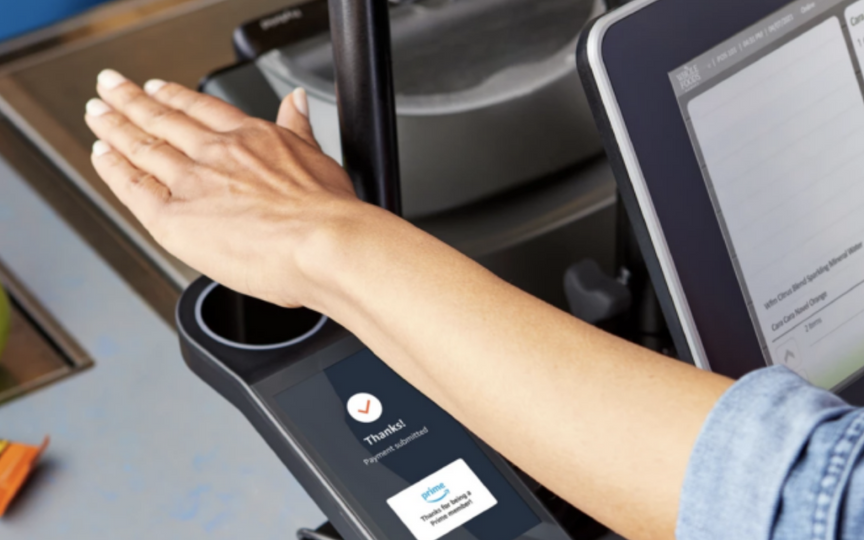Your Cart is Empty
Free Domestic Shipping on Orders Over $200
Free Domestic Shipping on Orders Over $200
Shop By Device
Shop By Collection
Pay With Your Palm? Amazon Palm Scanner Makes Big City Debut.

This year, Amazon rolled out its new palm scanning technology to several cities all over the country. It is now possible to pay for products in a store by simply passing your hand over a scanner. Is this an exciting innovation bringing unprecedented convenience or a potential security risk that could result in a loss of privacy?
Read on as we explore the pros and cons of this groundbreaking technology.
- Where is Amazon One Used?" href="#span-style-font-weight-400-where-is-amazon-one-used-span">Where is Amazon One Used?
- Amazon One: One Way To Unlock The World" href="#span-style-font-weight-400-amazon-one-one-way-to-unlock-the-world-span">Amazon One: One Way To Unlock The World
- Palm Payment Technology Security Risks" href="#span-style-font-weight-400-palm-payment-technology-security-risks-span">Palm Payment Technology Security Risks
- Payment Cards: A Thing of the Past?" href="#span-style-font-weight-400-payment-cards-a-thing-of-the-past-span">Payment Cards: A Thing of the Past?
Where is Amazon One Used?
Amazon One payment technology was recently rolled out at Whole Foods stores in the Southern California region, including Los Angeles, Malibu, Santa Monica, Irvine, Playa Vista, Sherman Oaks, and more. Northern California has also seen Amazon Go stores already have a presence in Bay Area, with four locations in San Francisco. The east coast has seen one of the biggest rollouts of Amazon's contactless payment at ten Amazon Go locations, two of which also offer Starbucks pickup.
All in all, Amazon's palm scanner is currently available at 156 business locations across the U.S.
Amazon One: One Way To Unlock The World
The new palm scanner has been dubbed “Amazon One” by the online retailing giant and is primarily branded around the selling point of convenience. They describe this new system as a “fast, convenient, contactless identity service that uses your palm.”
Rather than having to reach into a pocket, wallet, or purse to find your card, Amazon One enables you to swipe your hand over a small, circular device. Amazon's hardware captures the features of your palm, including your unique subcutaneous vein pattern and surface lines. The result is your one-of-a-kind palm signature.
Palm scanning technology is based on the fact that everyone has a completely unique palmprint. Security experts consider palm scanning to be one of the most secure forms of biometric authentication because, unlike your face, your handprint is not easily photographable by criminals, making it more difficult to steal.
But what if palm scanning technology falls into the wrong hands?
Palm Payment Technology Security Risks
Although considered more convenient, palm scanning possesses some inherent security risks. This is something that many people have been quick to point out with this ambitious new release from Amazon.The simple fact is that this system requires you to place your trust in Amazon’s Cloud Security.
Many have expressed concern about user privacy and what Amazon’s intentions may be for the massive data collection program that would be an inevitable part of the successful expansion of Amazon One.
Security concerns extended to the U.S. Federal Government when three senators—Amy Klobuchar (D-Minn.), Bill Cassidy (R-La.), and Jon Ossoff (D-Ga.)— sent a letter to the CEO of Amazon, Andy Jassy. In this letter, the senators demanded answers to several questions on details regarding what privacy protections existed for user data as well as details on exactly how Amazon plans to use private biometric data.
Many have pointed out the difference between Apple’s Face ID system that stores your biometric data on a separate hardware section of your own phone. This way, your data is always with you and kept separate from the rest of Apple’s hardware.
In addition to the risk that Amazon is selling your personal information, there is also the risk that your personal information is compromised by cybercriminals. If this were to happen to your passwords or your credit card number, you could simply have them changed. However, you cannot change your palm print—once stolen, it is stolen for good.
Payment Cards: A Thing of the Past?
At the end of the day, Amazon’s palm-scanning payment system may be a great new convenience, but users must carefully consider whether or not they trust Amazon with their private information. As cybersecurity threats demonstrate ever-increasing abilities to hack the latest technology, it seems only a matter of time before our scanned palm prints end up in the hands of criminals.
Until consumers are ready to place their faith and trust in Amazon's security, our guess is that payment cards won't be going away anytime soon.
Let us know what you think: Do you trust Amazon with your palm print?
Recent Articles
Newsletter
Join Our Community: Privacy, Security, Health Updates






